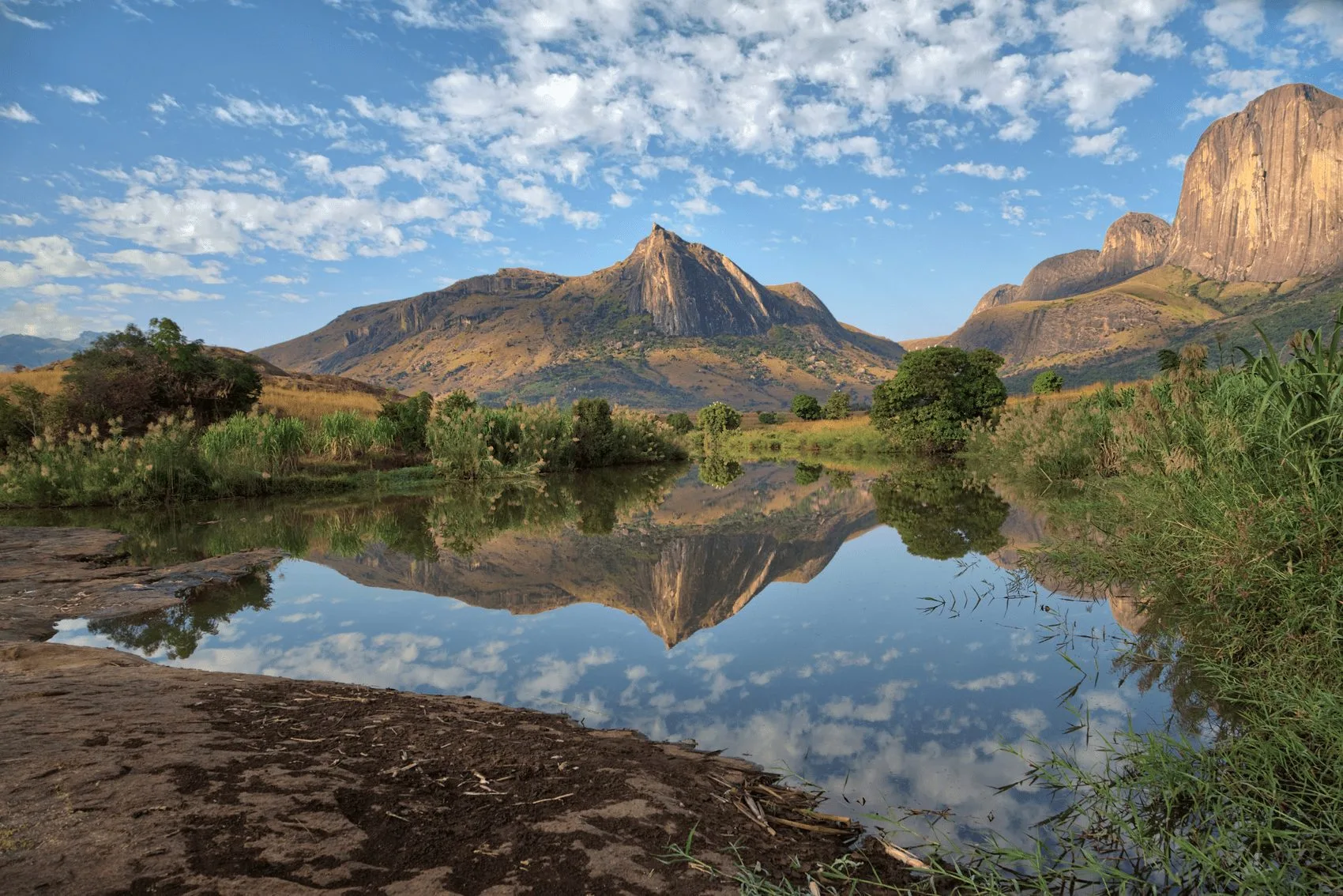Andringitra National park offers visitors a variety hikes, views of nature, and opportunities to view native wildlife. Read on to learn why we think that park is a must-see.
The Andringitra mountains are a granite outcrop in south-central Madagascar characterized by high mountains, deep valleys, and ridges.
These picture-perfect features are what make it one of Madagascar’s hidden gems. In fact, the park offers an exceptional combination of:
- Landscapes
- Thickets
- Small forest islands
- Deep valleys
- Granite outcrops
- Meadows
- Mountain ranges
- Large expanses
Andringitra region is steeped in legend and is a must-see destination when you visit Madagascar. But before we show you the park’s best attractions, let’s cover some history.
Brief History
The first inhabitants of the Andringitra region were early livestock herders in search of good pasture and favorable climate more than 200 years ago. Later, in the early twentieth century, more settlers inhabited the area’s valley bottoms, between 1,000 and 1,400 meters above sea level.
The new settlers converted much of the natural vegetation into flourishing cultural settlements. Around this time, explorers to the area (including Humbert and Perrier de la Bathie) noted the Andringitra region’s importance.
Specifically, it was noted to have high economic potential, given its rich cultural history, fertile alluvial soils, and abundant water resource. The central part of the mountain range was consequently declared a “Strict Nature Reserve” in 1927.
The Andringitra region was finally declared a National Park in the early 1990s after the Malagasy government took over the area’s environmental agenda from foreign donors through its Environmental Action Plan.
What to Expect
The Andringitra National Park is located in southeast Madagascar, 47 km south of Ambalavao, in the Fianarantsoa Province of Madagascar. The park covers 3,116 sq km of high altitude zones ranging between 650m and 2,658m above sea level.
These zones include high-altitude vegetation, mountain forest, and low-altitude rainforest. The park’s highest point is Mount Boby, at 2,658m above sea level, which is also the second-highest peak in Madagascar.
You can expect to find:
- 54 different types of mammals: including the brown fur Lemur, with dense brown or grey-brown fur, orange-red eyes, and long furry tails. There are also 13 more species of Lemur.
- 100 different bird species: including threatened species such as the Yellow-bellied sunbird and the rufous-headed ground roller.
- 55 species of frogs
- 788 species of amphibians
- More than 1 000 plant species: primarily concentrated in the mountain foot slopes and high altitude forest.
The diverse flora includes exotic species like the Osbeckia andringitrensis (an endemic bush of Andringitra), Rhipsalis Baccifera (a cactus with luscious green leaves), and the Helychrisum Mirabile (also known as the immortal and native to Madagascar).
The area’s natives also use many of these plants for medicinal purposes. Andringitra National Park is also home to the longest remaining continuous chain of rainforests remaining on the island.
The rainforest stretches 180 km from Ranomafana National Park in the north all the way to Pic Boby in the south. Three cultural groups live within the park’s boundaries, each with its distinct identity, values, and folklore.
The Bara Haronga ethnic group, who are avid rice growers, live in the tropical forest to the east of Andringitra. The tribe has mastered rainfed rice cultivation and sustainable slash-and-burn agriculture.
The northern foothills play host to the Betsileo tribe, also avid rice growers. This tribe takes a different approach to rice farming, sporting elaborately sculptured terraces and sophisticated irrigation system.
The result, aside from luscious harvests, you find stunning landscapes on the mountain flanks. Finally, the Bara tribe, primarily herders, lives in the west and south of the national park.
This area comprises open savannah, which is perfect for grazing. The Andringitra’s diverse landscape and equally varying climate have had a tremendous effect in shaping each social group’s cultural identity.
The Andringitra is one of the world’s shining examples of balancing human needs with conservation efforts.
Things to Do
The main activity at Andringitra National Park, and the main reason people visit here, is its epic hiking trails. With over 100 km of hiking trails within the park, it caters to a wide range of fitness, physical ability, and hiking experience.
The trails are very well-engineered, making even the most challenging trek reasonably accessible and safe.
Imarivolanitra Trail
The Imarivolanitra Trail is the Andringitra National Park’s crown jewel, taking you to the top of Boby Pic. This circuit typically takes three days, but you can hack it in two if you are particularly fit.
The two-day course includes a 12-hour second day, so it might be better just to take the three-day hike that most visitors prefer. The hike starts at the Namoly park entrance, taking you to the Pic Boby base camp.
This part of the hike takes four hours, going up 600m on a relatively gentle climb. Base camp is nestled by a stream next to a waterfall, where you’ll spend the night. Day two begins at 4 am for a two-hour trek to the summit.
There’s a stop-over at sunrise, where you’ll see the skyline under you. The final trek takes you to the peak of Pic Boby and the opportunity to record your victory in a guestbook. Then, it’s back down to base camp for breakfast.
Next, the hike takes you along endless plateaus, deep passes with mountains, and desert landscapes with break taking scenery. The next stop is the campsite before Tsaranoro, which is the end of the journey. Day three entails trekking the rest of the trip to Tsaranoro.
Ansaramanitra Trail
The Ansaramanitra is an easy 6 km circuit that takes about four hours. This is the most accessible trail in the park. The trail passes through dense forest, with a rewarding view of the Riambavy waterfalls (300m high) and the base of the Riandahy.
The waterfall is shrouded in legend, and locals believe that bathing in its waters brings fertility. There are also hidden caves to discover under a green forest.
Circuit Isahavato
This circuit takes about 12 hours and is 15 kilometers long. You can expect to traverse the high-altitude western plateau, view beautiful waterfalls, stumble on a beautiful natural pool, and view the breathtaking rocky plains below. This trek includes an overnight camp for a lovely night in the great outdoors.
Circuit Imaintso
For bird-watching fans, the 14 km Imaintso loop offers opportunities to spot rare birds. You also cross a variety of forest land, including a wet forest and low-altitude forest.
The environment is humid, but worth it for its epic views and ecosystem. Circuit Imaintso takes about 9 hours to complete.
Getting There
Whichever route you choose, you’ll need a 4×4 to get to the park. The road there can be bad, but the trip will be worth it. There is no public transport available to the park. There are two main routes to get you to the national park:
Morarano Entry from the Tsaranoro Reserve
This is the best route if you are coming from the south or are already in the Tsaranoro Reserve. If you’re planning to visit the Tsaranoro Reserve, you’ll most likely stay in the village of Andonaka.
This is where you find most of the accommodation. From here, go straight from the guide office. You’ll find the park entrance at the Morano village center, about 10 minutes from the guide office.
Namoly Entry
You’d use this route if you travel from the north and have no plans to visit the Tsaranoro Reserve. Drive south via the RN7 through the village of Ambalavao. Turn left just before the bus stop.
It’s a 43 km drive (about two hours) to the village of Namoly where you’ll find the park entrance. Park fees start at 45,000 AR per person (about $12).
Where to Stay
There are several campsites located inside the Andringitra National Park, including:
- Andriampotsy campsite
- Lataranomby campsite
Some people may not find the campsite accommodations adequate. You can expect communal showers, relatively small spaces, and no electricity except for the main areas.
In this case, there are more luxurious accommodations outside the Andringitra National Park, including:
Camp Catta
This camp has a few different accommodation options, including comfortable bungalows complete with solar water heaters and private facilities. There are also tents available for budget travelers and the option to pitch your tent.
You can reach out to Camp Catta at:
Tel: +261 34 13 449 86 or +261 34 96 957
Email: camp.catta@campcatta.com or helgamada@gmail.com
Fax: 00 33 5 17 47 50 11
Website: campcatta.com
Tsara Camp
The Tsara Camp offers fully furnished tents complete with beds. The staff provides hot water every morning in washbasins. The accommodations also include a small outside private shower and chemical toilet.
You can contact Tsara Camp at:
Tel: +261 202 253070
Email: tsaracamp@boogiepilgrim-madagascar.com
Fax: +261 202 253069
Andringitra National Park Travel Tips
I’ll leave you with a few quick tips to make your visit to the Andringitra National Park more comfortable:
The best time of year to visit is from late August to March. Most flowering plants bloom during this time. Also, small wildlife is most active during these months.
- You’ll need a guide for most hikes. Guides are also very knowledgeable about plants and animals.
- Consider hiring porters for the longer treks or overnight trek. They’ll make your work easier, including even cooking for you!
- Pack some warm clothing for your hike to Peak Boby. The temperatures can get freezing.
- Air Madagascar, the only domestic airline, can be unpredictable if not unreliable. Make an allowance between your domestic and international flight home. Book your domestic flight at least 24 hours before your international flight is due.
- Take plenty of Imodium. The trekking conditions can be physically demanding, and you’ll need all the nutrients you can get.



